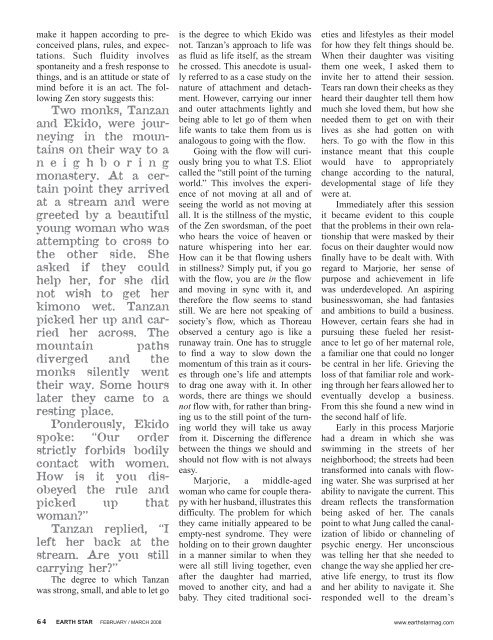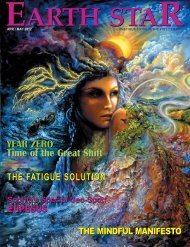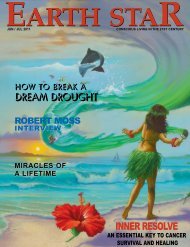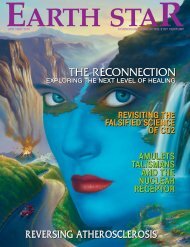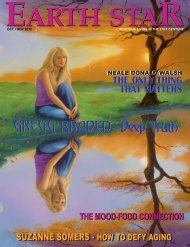GREGG BRADEN GREGG BRADEN - Earthstar
GREGG BRADEN GREGG BRADEN - Earthstar
GREGG BRADEN GREGG BRADEN - Earthstar
- No tags were found...
Create successful ePaper yourself
Turn your PDF publications into a flip-book with our unique Google optimized e-Paper software.
make it happen according to preconceivedplans, rules, and expectations.Such fluidity involvesspontaneity and a fresh response tothings, and is an attitude or state ofmind before it is an act. The followingZen story suggests this:Two monks, Tanzanand Ekido, were journeyingin the mountainson their way to an e i g h b o r i n gmonastery. At a certainpoint they arrivedat a stream and weregreeted by a beautifulyoung woman who wasattempting to cross tothe other side. Sheasked if they couldhelp her, for she didnot wish to get herkimono wet. Tanzanpicked her up and carriedher across. Themountain pathsdiverged and themonks silently wenttheir way. Some hourslater they came to aresting place.Ponderously, Ekidospoke: “Our orderstrictly forbids bodilycontact with women.How is it you disobeyedthe rule andpicked up thatwoman?”Tanzan replied, “Ileft her back at thestream. Are you stillcarrying her?”The degree to which Tanzanwas strong, small, and able to let gois the degree to which Ekido wasnot. Tanzan’s approach to life wasas fluid as life itself, as the streamhe crossed. This anecdote is usuallyreferred to as a case study on thenature of attachment and detachment.However, carrying our innerand outer attachments lightly andbeing able to let go of them whenlife wants to take them from us isanalogous to going with the flow.Going with the flow will curiouslybring you to what T.S. Eliotcalled the “still point of the turningworld.” This involves the experienceof not moving at all and ofseeing the world as not moving atall. It is the stillness of the mystic,of the Zen swordsman, of the poetwho hears the voice of heaven ornature whispering into her ear.How can it be that flowing ushersin stillness? Simply put, if you gowith the flow, you are in the flowand moving in sync with it, andtherefore the flow seems to standstill. We are here not speaking ofsociety’s flow, which as Thoreauobserved a century ago is like arunaway train. One has to struggleto find a way to slow down themomentum of this train as it coursesthrough one’s life and attemptsto drag one away with it. In otherwords, there are things we shouldnot flow with, for rather than bringingus to the still point of the turningworld they will take us awayfrom it. Discerning the differencebetween the things we should andshould not flow with is not alwayseasy.Marjorie, a middle-agedwoman who came for couple therapywith her husband, illustrates thisdifficulty. The problem for whichthey came initially appeared to beempty-nest syndrome. They wereholding on to their grown daughterin a manner similar to when theywere all still living together, evenafter the daughter had married,moved to another city, and had ababy. They cited traditional societiesand lifestyles as their modelfor how they felt things should be.When their daughter was visitingthem one week, I asked them toinvite her to attend their session.Tears ran down their cheeks as theyheard their daughter tell them howmuch she loved them, but how sheneeded them to get on with theirlives as she had gotten on withhers. To go with the flow in thisinstance meant that this couplewould have to appropriatelychange according to the natural,developmental stage of life theywere at.Immediately after this sessionit became evident to this couplethat the problems in their own relationshipthat were masked by theirfocus on their daughter would nowfinally have to be dealt with. Withregard to Marjorie, her sense ofpurpose and achievement in lifewas underdeveloped. An aspiringbusinesswoman, she had fantasiesand ambitions to build a business.However, certain fears she had inpursuing these fueled her resistanceto let go of her maternal role,a familiar one that could no longerbe central in her life. Grieving theloss of that familiar role and workingthrough her fears allowed her toeventually develop a business.From this she found a new wind inthe second half of life.Early in this process Marjoriehad a dream in which she wasswimming in the streets of herneighborhood; the streets had beentransformed into canals with flowingwater. She was surprised at herability to navigate the current. Thisdream reflects the transformationbeing asked of her. The canalspoint to what Jung called the canalizationof libido or channeling ofpsychic energy. Her unconsciouswas telling her that she needed tochange the way she applied her creativelife energy, to trust its flowand her ability to navigate it. Sheresponded well to the dream’s64 EARTH STAR FEBRUARY / MARCH 2008 www.earthstarmag.com


